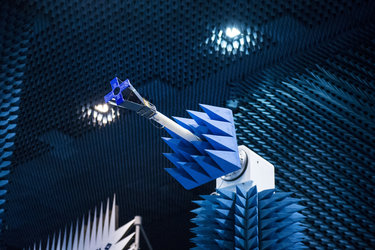Multi-Needle Langmuir Probe Tested and Ready for Launch
Norway’s multi-Needle Langmuir Probe (m-NLP) successfully passed the ESA Acceptance Review, after undergoing thermal vacuum testing in ESTEC's Mechanical Systems Laboratory. The probe is now ready for launch to both the International Space Station and the Moon. M-NLP will be used to sample the in-situ space weather environment to an extraordinarily fine level of detail – cementing future Norwegian and ESA-led payloads and missions.
Launched to the International Space Station (ISS) by SpaceX, m-NLP will be fitted onto the external porch of the European-built Bartholomew platform. Open to space, m-NLP will map the ionospheric plasma surrounding the ISS to an unprecedented high level of detail. Almost 10000 measurements per second will be made continuously along its orbit. This offers a significant level of improvement – one order of magnitude higher – than m-NLP previously achieved on NorSat-1 and the Dutch CubeSat BIRK-II.

Numerous Langmuir probes have flown in space to measure plasma properties - often called the fourth state of matter. Measurements are taken by applying a series of voltages to the probe, where the collected current is used to identify properties of the plasma, such as electron and ion density, as well as temperature. An instrument sweep typically lasts from half to two seconds. Operating at orbital velocities of around 7 km/s results in a maximum sample rate of one sample per 3.5 km of space. is is far too coarse to capture those small ionospheric structures that are disturbing, among other things, to satellite navigation signals and causes signal scintillations. Instead, m-NLP extends a quartet of miniature cylinders, each set to a different, but fixed voltage, producing a much narrower spatial resolution – down to less than two meters, while also achieving a wider power range.

The same, but smaller version of m-NLP will also set off to the Moon onboard the United Arab Emirates Rashid rover, scheduled to be launched aboard JAXA’s Hakuto-R lander on a SpaceX Falcon 9 rocket. This m-NLP will survey the plasma environment immediately above the lunar surface, as the regolith interacts with sunlight.
m-NLP was co-funded by both ESA’s Directorate of Science PRODEX programmes and the Directorate of Technology GSTP programme. Eidsvoll Electronics designed and built the electronics, while the University of Oslo improved the boom system designed from NorSat-1 for enhanced performance. A future radiation-hardened version of m-NLP could be capable of opening at higher orbits and as potentially part of a space weather constellation. This new design concept is currently under study in ESA’s Space Situation Awareness Programme. Multiple m-NLP instruments onboard a fleet of satellites could be used to develop an improved space weather forecast ability and the prediction of signal losses of Global Navigation Satellite Systems.





